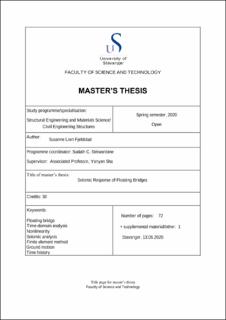| dc.contributor.advisor | Sha, Yanyan | |
| dc.contributor.author | Fjeldstad, Susanne Lien | |
| dc.coverage.spatial | Norway | en_US |
| dc.date.accessioned | 2020-09-25T08:16:29Z | |
| dc.date.available | 2020-09-25T08:16:29Z | |
| dc.date.issued | 2020-06-15 | |
| dc.identifier.uri | https://hdl.handle.net/11250/2679596 | |
| dc.description | Master's thesis in Structural engineering | en_US |
| dc.description.abstract | The object of this study is to collect the results of an end-anchored floating bridge when it is subjected to seismic excitations. The bridge is an end-anchored floating bridge, mounted on 46 separate pontoons, with an elevated cable-stayed part in the south end supported by a 230 m tall bridge tower. The cable-stayed part and the floating part constitutes a total length of 5.5 km. The bridge has a location in Bjørnafjorden and is a project purposed by the Norwegian Public Road Administration (NPRA). A powerful finite element analysis (FEA) software, USFOS, is used to perform nonlinear analyses on the bridge structure.
Due to no design guidelines for floating bridges, requirements, and analysis methods from Eurocode 8, AASTHO and NORSOK for general bridges and offshore structures are discussed to make a suitable solution for floating bridges against seismic excitations.
Time-domain analysis has been performed in USFOS and the behavior of the bridge is studied when subjected to seismic excitations. The seismic ground motions are generated by Dr. Kaiming Bi where the spatially correlated time histories are generated in accordance with the design spectra from Eurocode 8-2. A Sobczyk model is used to describe the coherency loss between the ground motions for the different fixed boundary locations and a shape function is applied to modulate the simulated time histories.
During the master, a bridge model made by Ida Osvoll is used to run numerical analyses on the bridge, subjected to seismic excitations. The model is carefully reviewed and understood before the analyses are completed. Motions are collected along the length of the bridge to see the global response for all load cases. Forces and stresses in the bridge girder are also collected from the simulations to see how the bridge reacts to the excitations.
Furthermore, numerical simulation of floating bridges shows that the floating bridge is reliable when subjected to seismic excitations of low to moderate seismicity. In other words, seismic excitations with PGA=0.08g do not have a significant impact on floating bridges. | en_US |
| dc.language.iso | eng | en_US |
| dc.publisher | University of Stavanger, Norway | en_US |
| dc.relation.ispartofseries | Masteroppgave/UIS-TN-IMBM/2020; | |
| dc.subject | materialteknologi | en_US |
| dc.subject | byggkonstruksjon | en_US |
| dc.title | Seismic response of floating bridges | en_US |
| dc.type | Master thesis | en_US |
| dc.description.version | submittedVersion | en_US |
| dc.subject.nsi | VDP::Teknologi: 500::Materialteknologi: 520 | en_US |
| dc.source.pagenumber | 72 | en_US |
